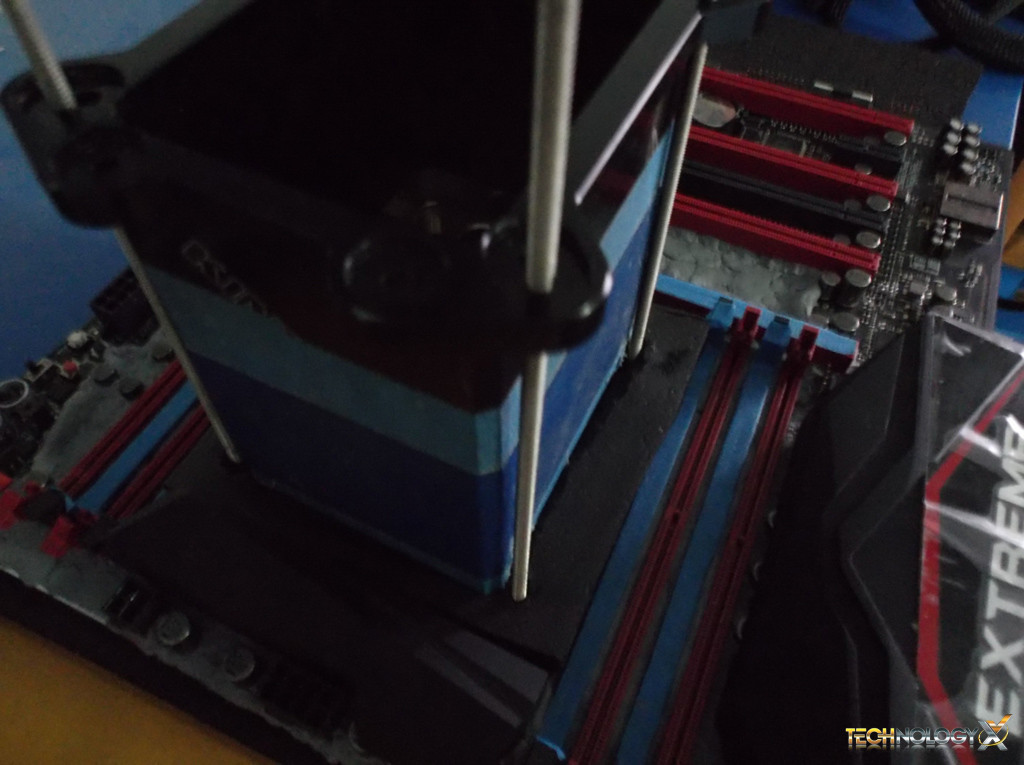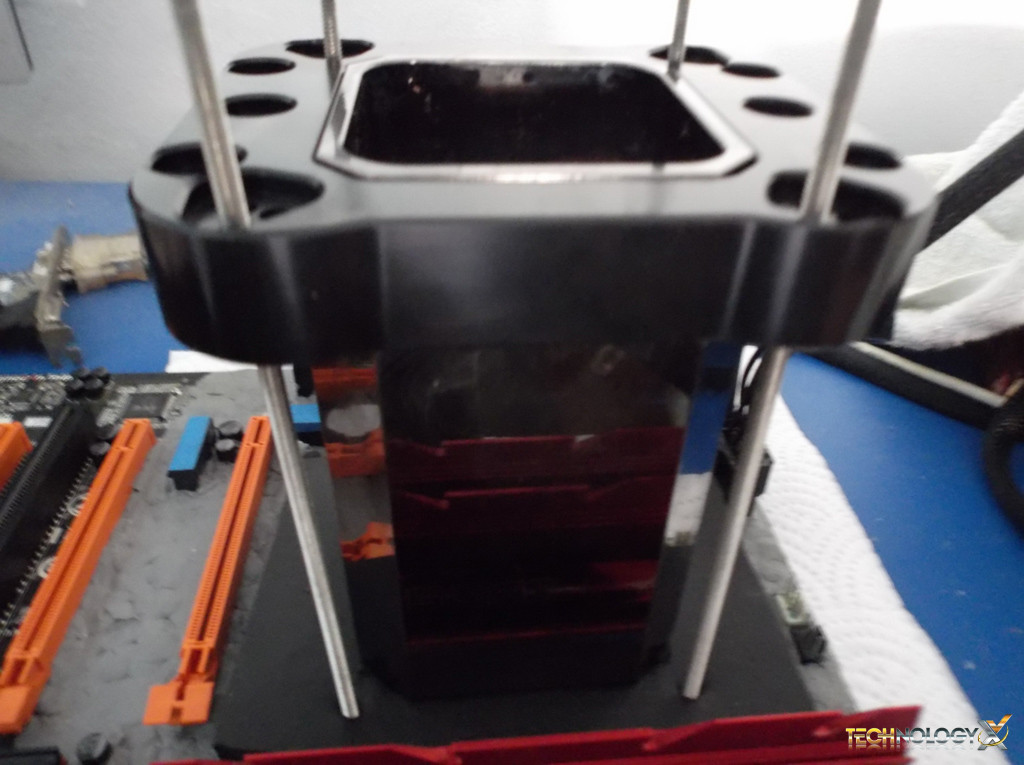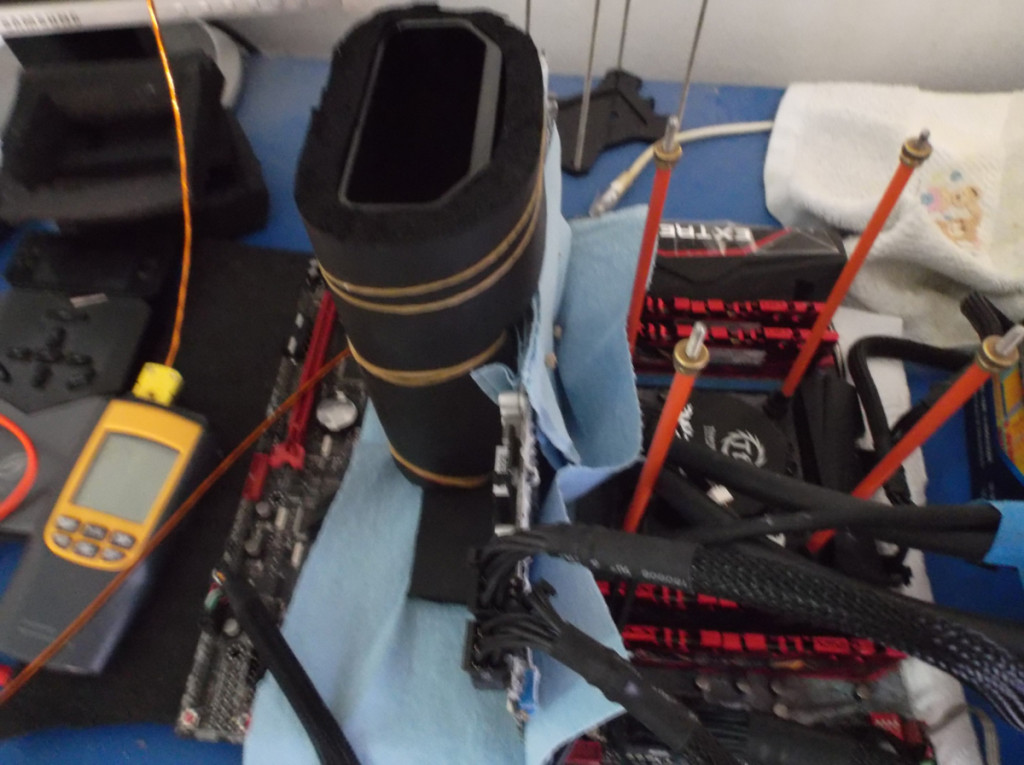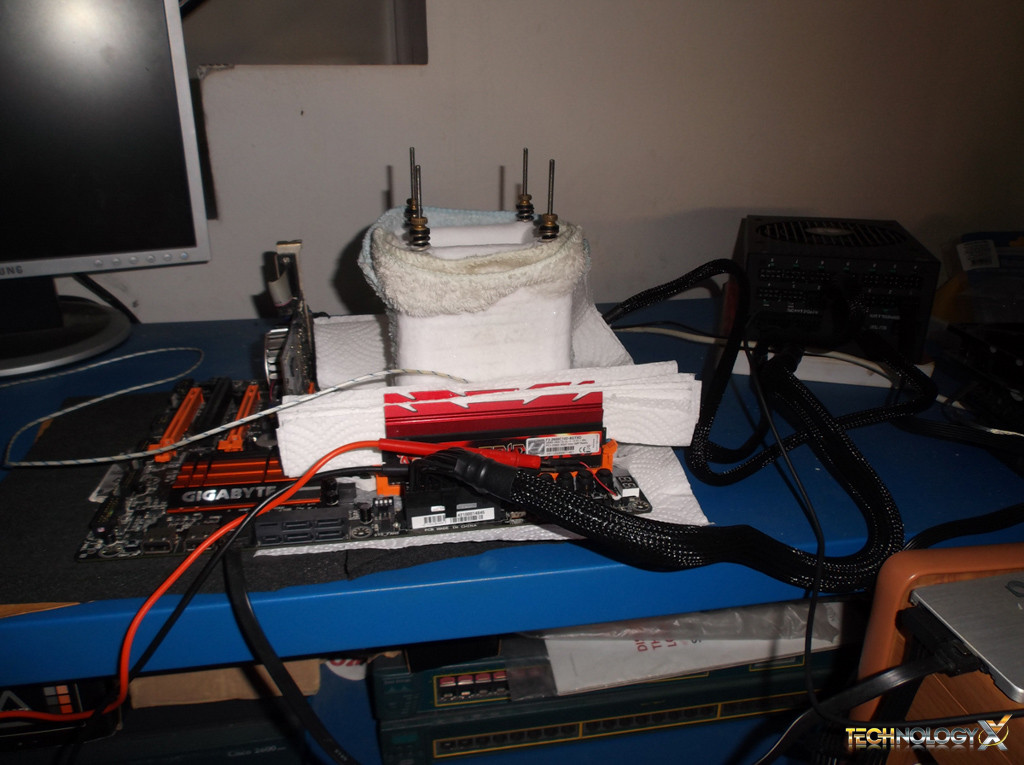POT MOUNTING
Pot mounting is as easy as mounting any cooler on your motherboard, even GPU pots are easy to mount. As you will see in the following pictures we have used a quarter inch piece of closed cell foam as a gasket to help the cold be more directed to the CPU as well as a nice seal of the socket area. Below is the the Venom pot mounted on a Rampage V Extreme.
The Dragon F1 Dark Extreme Edition mounted of a Gigabyte Z97 SOC Force.
The Tek-9 Fat mounted on a graphics card with insulation.
When mounting your pots, be careful not to over tighten the screws as you may damage the socket or in the case of a graphics card that has a bare die, you crack the die. We usually do about ten turns on each screw on the CPU pots, while on the GPU pot we recommend until it is firm, but still have some wiggle room. When you want to bench your graphics card, you should also mount your CPU pot and cool you CPU with LN2 or DICE as well for best results. This is not a must do, just like benching your CPU, you don’t need to use a GPU Pot or even a high end graphics card for that matter. It is entirely up to you and what you want to bench.
FINAL THOUGHTS
Subzero benchmarking is not for everyone, there is a lot to do to get started, as well as a lot to learn about the benchmarks themselves. For those willing to take the step into the world of subzero benchmarking and overclocking, it can be quite rewarding as a hobby or for those want to get serious you can compete against others from around the world on HWBot as well as HWBot’s online competitions.
A lot people just like the thrill of benchmarking both ambient and subzero to see the best they can get out of their hardware. Benchmarking is not limited to the latest and best hardware on the market, as many play with older generation hardware to try to beat scores of that generation. As a precaution, it is important to note that Subzero benchmarking may harm your hardware so do so at your own risk! That said, if you make the jump in to subzero benchmarking, have fun and best of luck with your new hobby.
 Technology X Tomorrow's Technology Today!
Technology X Tomorrow's Technology Today!





Why don’t you just use conformal coat the insulate the board from moisture, that’s what it’s designed to do? We use Humiseal 1B31 at work for military boards. It glows blue under UV too so would look groovy at an event if you could get some black lights =P
Hi,
I have toyed with idea of using conformal coating and just need to get some. Thanks for giving me a product name. i will also look out for others and not much in conformal coating is available here in Thailand so will have to probably import it. Not a problem tho and your right it does work and would look nice with some UV lights 🙂
Thanks for the article! Very well written. It’s classified as hazardous material so transporting usually has an extra cost along with certain rules. Check into that before ordering =) Generally we buy from https://www.ellsworth.com/products/conformal-coatings/
or the like, but I think you can even get it on Amazon.
Thank you for comments, I will certainly look out for that product as well. Much appreciated your kind words too 🙂
Hello,
great guide
I have my own method i use, it is a combination of common insulation methods.
Required Materials:
Vaseline
Eraser
Liquid Electrical Tape
Electrical Tape
Neoprene Insulation
Armaflex.
paper towel
Painters tape
Sorry i have no photos so i will half to describe it to the best of my abilities, if you have any questions just ask.
Step 1
Remove everything and anything that can be screwed off of the board. This includes the heat sinks and cpu security bracket.
We are going to be covering the top of the board in a thick layer of Liquid Electrical Tape, this will make a water proof seal. if the liquid tape gets under a pci slot then it is stuck there. The board will still work but your chance of RMA has greatly diminished lest something bad happen. To prevent this we are going to take the eraser and roll it into long strips, place the thin strips in any tight space where the liquid tape won’t be able to be removed. This means sealing off the bottom of PCI Lanes, The edge of the cpu socket, Mosfets in the power delivery. Use your common sense.
Step 2
Now that all your tight spaces are sealed off take your LET and start painting it across the board. Your probably going to want to put a cpu in the socket to prevent it from dripping into the socket and ruining your board.You want to paint a thick layer, remeber there is no such thing as to much tape. The more tape you us the easier it is to remove. Generally you shouldn’t be able to see the colour of the pcb through the tape. (pro tip, well the paint is what you should poke through any mounting holes, it will save you alot of time)
Step 3
Rub Vaseline into the PCI and DIMM slots that you are using, its ok it can be removed completely with a blow-dryer. Apply Vaseline to the cpu socket. Just carefully place a small amount of Vaseline in the centre of the socket and then hit it with a blow dryer to spread it around the socket. Keep doing this until you have gotten decent coverage in the socket.
Step 4
put everything back on the motherboard,
Step 5 (optional)
You can now apply a layer of LET to the back of the board, there isn’t anything that needs to be sealed with eraser, this only takes a few minuets and creates extra protection but ins’t that necessary.
Step 6
Place the board on a sheet of Neoprene, this will seal the back of the board off completely and is why step five is not to important. sandwich the neoprene between backplate of your mounting system and the motherboard. Poke wholes for the screws so that the neoprene gets pressed into the board once you apply the pot.
Step 7
wrap your pot in a layer of painters tape and then wrap it in a thick layer of armaflex insulation tape.
From here you can follow Stuarts guide starting at page 4.
Sorry if it was unclear in anywaym, i did my best.
As me anything if you need
Thanks Sean,
Great layed out method you use, certainly solid 🙂